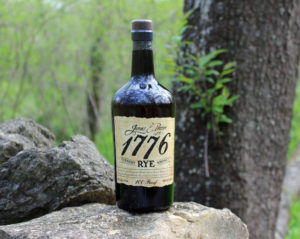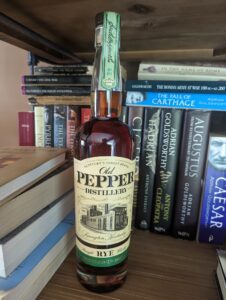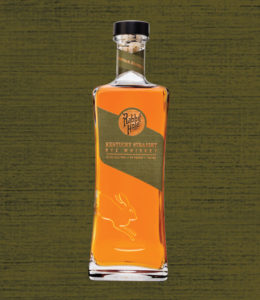Not Every Sourced Brand Comes From MGP These Days
By Richard Thomas

(Credit: Richard Thomas)
Some ideas die slow, hard deaths, and as recently as last year I found myself reading yet another magazine article warning consumers that their bottle of supposedly craft whiskey really came from the big distillery in Indiana, MGP. Moreover, I continue to hear this notion virtually every time I engage with enthusiasts, and read it fairly regularly from bloggers.
This notion is so pervasive and embedded that it leads to some seriously mistaken conclusions. James E. Pepper Distillery, located just a mile from my home, recently launched a bottled in bond rye whiskey. Some have claimed that rye is made with the same stock as the their flagship 1776 rye whiskey. While that 1776 Rye has always been sourced through MGP, the bonded rye is entirely in-house, so this claim is quite erroneous. Slightly more understandable, but just as ill-informed, is the belief that every 95% rye, 5% malted barley mash bill rye whiskey is made at MGP; these days, an increasing number of such whiskeys are made by other distillers, either as follow ons for their previously MGP-sourced brands or chasing the flavor profile of what is a ubiquitous style of rye whiskey.
Admittedly, there was a good reason for believing this generality, even if it was never entirely true. As the Bourbon Boom gained breakneck momentum during the 2010s, one Kentucky Major after another withdrew from the business of trading stock whiskey (i.e. aged and held in stock). Excepting Heaven Hill, the big distillers in Kentucky were often reticent about dealing in stock whiskey, so who provided what to whom was always a guessing game. Nonetheless, demand pressures on their own brands meant they stopped selling stocks and let existing contracts come to a close. That left MGP, a major distillery with a large stock of aging and aged whiskey, but no brands of its own to feed, as the one of the very few games in town… although, as shall be detailed below, never the sole game. Yet by the end of the decade, some major competitors were already entering the scene, as well as several dozen minor ones.

(Credit: Richard Thomas)
Moreover, MGP themselves decided to get fully into the game as a brand-holder, not merely as a supplier. The company renamed the Lawrenceburg, Indiana distillery Ross & Squibb, and began acquiring brands that were sourced through their distillery. The single largest example of this was the buy-out of Luxco (which brought with it the Lux Row Distillery in Kentucky), and just two months ago they announced the acquisition of Penelope Bourbon.
This development of MGP’s status has led to two major changes in the business of sourced whiskey in America. First, it’s not accurate to describe brands that were once made with MGP’s whiskeys, but now belong to the company (such as Rebel Yell and Minor Case) as being “sourced.” Also, brands relying on MGP contracts must now contend with their supplier also being a competitor.
Alberta Distillers
Underlining how ignorant it is to assume that any sourced rye must come from MGP is that a handful of the most established brands in rye whiskey are based on 100% rye sourced from Canada. Alberta Distillers were the source behind the original 10 Year Old iteration of Whistlepig. Also coming out of Alberta are Masterson’s, 35 Maple Street, Jefferson’s 10 Year Old, Lock Stock and Barrel and Pendleton, and that isn’t including the distillery’s in-house brands. Alberta Distillers are clearly secondary to MGP as a supplier of rye whiskey to sourced brands in terms of number of brands served, but a lot of those expressions have age statements of 10 to 16 years, so their presence in the mature and middle aged end of the spectrum is quite outsized.
Bardstown Bourbon Company (BBCo)

(Credit: Richard Thomas)
The most important development in the business of sourcing whiskey in America was the start of production at Bardstown Bourbon Company in 2016. Although the company has its own brand, the core of its business model is to provide contract production and maturation services for other brands, with a secondary role as offering a “home” visitor center for those brands. It seems like there is at least one new rickhouse under construction whenever I even so much as drive past the distillery, located outside Bardstown on the Martha Lane Collins Parkway; repeated expansions has raised the distillery’s output to the point where I place it among the ten largest distillers in Kentucky; and last year the company was making over four dozen distinct whiskeys for more than three dozen customers.
New Riff Distillery And Others
Compared to BBCo, New Riff is less a challenger to MGP than an example of just how many minor market challenges could be out there, because once upon a time they were engaged in contract production for Rabbit Hole Bourbon. Moreover, the whiskey New Riff was making for Rabbit Hole was one of those not-MGP 95% ryes I referred to earlier. Now that Rabbit Hole is operational and making its own products since 2018, that makes two medium-sized distillers that are making their own 95% rye. Somewhat ironic is that New Riff got started with OKI, a bourbon brand sourced through MGP.

(Credit: Rabbit Hole Distilling)
It’s unknown whether New Riff is still engaged in contract production today, and their attitude towards their work for Rabbit Hole is best described as “neither confirm or deny.” This is an important consideration for industry watchers, since we know many distillers in the small and medium-sized classes probably have “time” available on their production equipment, and want customers to fill that time until demand for their in-house products catches up with their capacities. Most of these contracts aren’t secrets, but they aren’t publicized either.
For example, I know that Fresh Bourbon made at least their initial product through a contract with Hartfield & Company, a small distillery in Paris, Kentucky, but only because I was there for the launch of Fresh Bourbon and spoke with all concerned. It’s an example of both how some contract production is done on a small scale and not widely announced, so not necessarily every “made in Indiana” whiskey comes from MGP.
Those Folks In Tullahoma
Like Alberta Distillers, an unnamed distillery in Tullahoma, Tennessee has been providing a steady supply of aged bourbon for many brands. Fans of Barrell Bourbon have long been familiar with this unnamed Tullahoma distillery, which could only possibly be Cascade Hollow (home of George Dickel), as it has been one of the company’s two principal suppliers.
The only difference between George Dickel Tennessee Whiskey and a Tennessee bourbon made at the same place is the Lincoln County Process. Presumably, parent company Diageo ordered Dickel to begin producing and laying up bourbon in stock for use in other products, and some of that stock has since appeared in sourced, independent brands.


